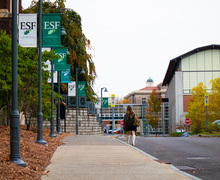Lawmakers, organizations work to reduce gun violence in Syracuse
Several shootings happened in Syracuse over winter break, shedding light on the city’s issues with ongoing gun violence.
Five gun-related events at the end of December closed 2014 as one of the deadliest years for Syracuse with over 20 homicides. The sheer number of homicides and gun-related incidents left lawmakers and organization leaders alike questioning what went wrong this year and what must be done in the future to prevent further incidents.
“It’s very concerning to me. Obviously there are people being shot,” Syracuse Common Councilman Bob Dougherty, who also personally knew one of the shooting victims, said. “It’s a tragedy whenever it happens.”
Though causes include domestic disputes and verbal altercations, the most unifying cause for recent bouts of deadly violence have been gang-related. However, Syracuse’s violence does not affect a majority of its residents, Dougherty said.
“The average person doesn’t really have anything to worry about,” he said. “This is one group going after another group, not really interested in your law-abiding citizen.”
Another issue with Syracuse’s homicide rate is that many of the crimes go unsolved.
More than 60 percent of Syracuse’s homicide cases remain unclosed, which is a much higher rate than the national average of around 40 percent, according to Syracuse.com.
Ongoing efforts from both local organizations and the police force are aimed at stopping this pressing citywide issue. Dougherty added that without the organizations, there could be more shots fired and more violence.
“Lawmakers can create the legislation, but the police are the individuals that must enforce the policy,” said Syracuse Common Council Majority Whip Jake Barrett. “There is little to say, but much to do”.
Lawmakers are currently putting initiatives in place to curb violence in at-risk areas. One of the projects being put into action is Syracuse Truce, which is an anti-gang and anti-shots fired initiative. They are also attempting to lead by example, hoping others will follow along.
“You just have to be a leader,” Barrett said. “Obey gun laws, just do the right thing.”
Outside of City Hall, anti-violence organizations, such as Cure Violence, which is an affiliate of the New York SNUG program, are focusing on changing the behaviors of at-risk teens and directing them to safer methods of taking out their frustration.
“We are a responsive agency to changing the mindset and the culture of the area,” said Raheem Mack, program manager for Syracuse SNUG. “We go into communities where there are gun crimes, and spread the message that there is an opportunity for change. We look for other ways to deal for violence.”
Though the police themselves are the ones who hunt down perpetrators of violence, the organizations are essential to changing the way of life in violent cities by calling for behavioral change, Mack said.
Overall, change must come from within, Barrett said. Mindset changes from gangs themselves are one of the only concrete solutions to such a complicated problem, he said. However, lawmakers, police and organizations are only able to deal with the causes and effects, not the violence itself.
“It’s hard to stop a teenager from doing what they want to do,” Dougherty said.
Published on January 14, 2015 at 12:01 am
Contact Hanna: hrhorvat@syr.edu





